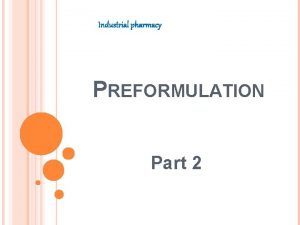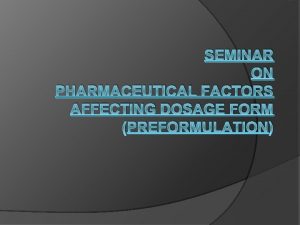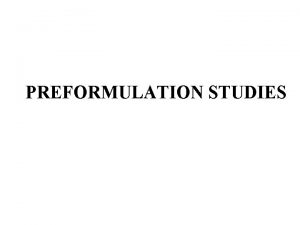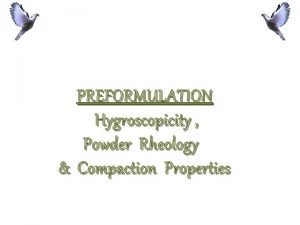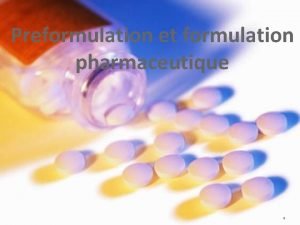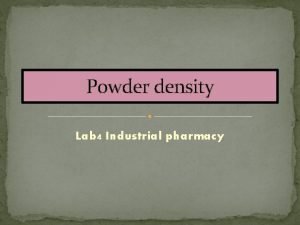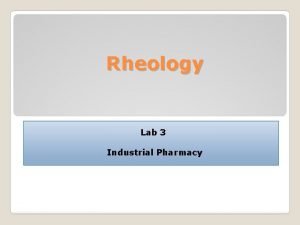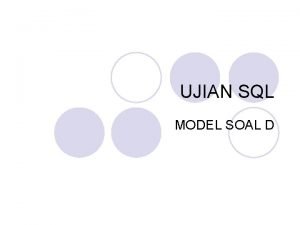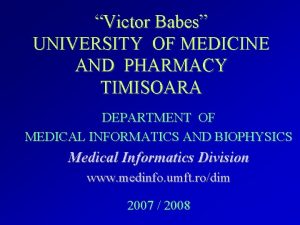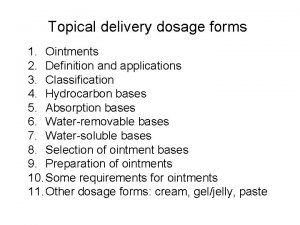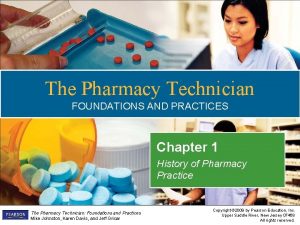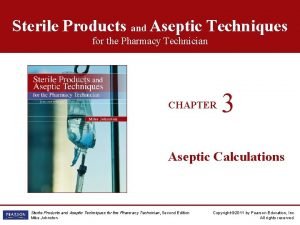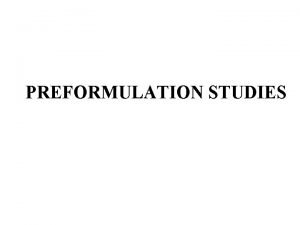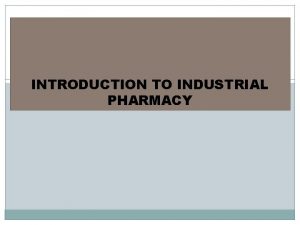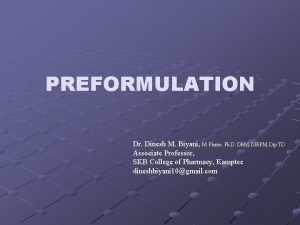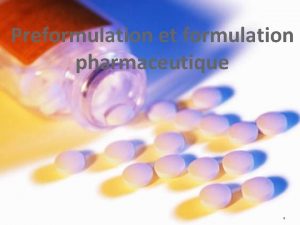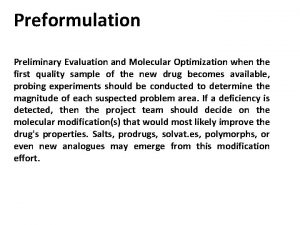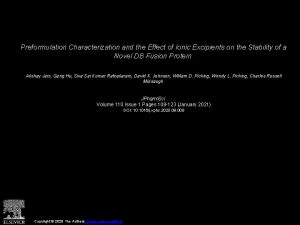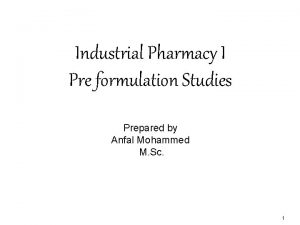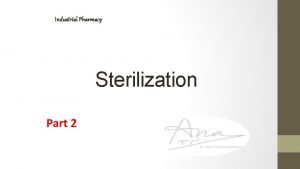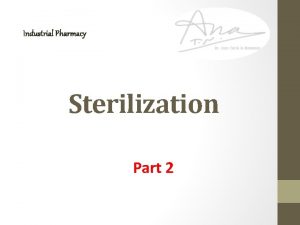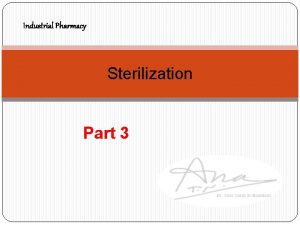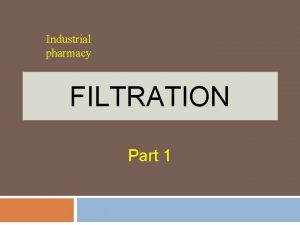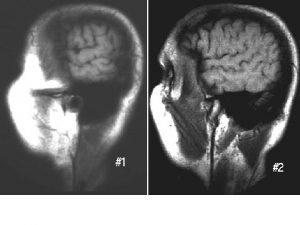Industrial pharmacy PREFORMULATION Part 1 PREFEORMULATION These studies



































- Slides: 35

Industrial pharmacy PREFORMULATION Part 1

PREFEORMULATION These studies that focus on physicochemical properties of the new compound affect drug performance and development of an efficacious dosage form. PRELIMINARY EVALUATION AND MOLECULAR OPTIMIZATION Once a pharmacologically active compound has been identified The project team consisting of representatives from the disciplines has responsibility for assuring that the compound enters the development process in its optimum molecular form. The physical pharmacist must focus on how the product will be formulated and administered to patients.

If the first quality sample of the new drug is available (probing experiments should be conducted to determine for each suspected problem area). If a deficiency is detected The project team should decide on the molecular modification(s) to improve the drug's properties. Ex: Salts, prodrugs, solvates, polymorphs.

SALTS: Salts of organic compounds are formed by the addition or removal of a proton to form an ionize drug molecule, which is then neutralized with a counter ion. Ex: Ephedrine hydrochloride (organic salts that is more water-soluble than the corresponding un-ionized molecule, and having more dissolution rates, and possibly improving bioavailability). Problems associated with salt formation: 1 - poor crystallinity 2 - various degrees of solvation or hydration 3 - hygroscopicity 4 - instability due to an unfavorable p. H in the crystalline microenvironment.


PRODRUGS: Formed with any organic molecule having a chemically reactive functional group. Prodrugs: synthetic derivatives (e. g. , esters and amides) of drug molecules that may have intrinsic pharmacologic activity but usually must undergo some transformation in vivo to liberate the active drug molecule. Note: through the formation of a prodrug, a variety of side chains or functional groups may be added (to improve the biologic and/or pharmaceutical properties of a compound).

Biological response parameters that altered by prodrug formation are: 1. Absorption due to increased lipophilicity or increased water solubility 2. Duration of action via blockade of a key metabolic site 3. Distribution to organs due to changes in lipophilicity. Ex: steroid and prostaglandin prodrug Pharmaceutical improvements resulting from prodrug formation include: 1. Stabilization 2. Increase or decrease in solubility 3. Crystallinity 4. Taste 5. Odor

EX: ERYTHROMYCIN ESTOLATE IMPROVED PHARMACEUTICAL PROPERTIES) Problem: In aqueous solutions, protonated erythromycin is water-soluble, has a bitter taste, and is rapidly hydrolyzed in gastric acid (t 10% = 9 sec) to yield inactive decay products. Solution: water-insoluble lauryl sulfate salt of the propionate ester prodrug (estolate) was formed for use in both suspension and capsule dosage forms. But: Erythromycin propionate is inactive as an antimicrobial and must undergo ester hydrolysis to yield bioactive erythromycin. Ex: In an oral q. i. d. bioavailability comparison between enteric coated tablet of erythromycin base and non enteric capsule erythromycin estolate. lipophilic ester prodrug was absorbed four times more efficiently than the formulated free base, but hydrolyzed only 24% in serum to produce equivalent plasma levels of bioactive erythromycin base. prodrug was used to overcome a pharmaceutical formulation problem without compromising bioavailability. (PRODRUG WITH

PROBLEM OF PRODRUG: Prodrugs that have been esters or amides designed to increase lipophilicity. Decreases water solubility and thus decreases the concentration gradient across the cell membrane, which controls the rate of drug absorption. Solution: making of water soluble prodrugs by adding selected amino acids (ex: lysine ester prodrug of estrone) that are substrates for enzymes located in the intestinal brush border. Assuming that enzyme cleavage was not rate-limiting, and that the liberated drug molecule would remain in the lipophilic membrane, then the resulting membrane transport of the parent compound should be very rapid, owing to the large concentration gradient of liberated drug across the membrane.

Once the optimum molecular form of a drug has been selected Formulation development initiates Prompts other disciplines to begin their task in the drug development process The objective of this phase is the quantitation of those physical chemical properties that will assist in developing a stable, safe, and effective formulation with maximum bioavailability.

BULK CHARACTERIZATION Bulk properties for the solid form, such has particle size, bulk density and surface morphology, are also likely to change during process development. 1. Crystallinity and Polymorphism Crystal habit and the internal structure of a drug can affect bulk and physicochemical properties, which range from flowability to chemical stability. Crystal habit: is the description of the outer appearance of a crystal. Internal structure: is the molecular arrangement within the solid.

q q A single internal structure for a compound can have several different habits, depending on the environment for growing crystals. Changes with internal structure usually alter the crystal habit while such chemical changes as conversion of a sodium salt to its free acid form produce both a change in internal structure and crystal habit. Characterization of a solid form involves: (1) verifying that the solid is the expected chemical compound (2) characterizing the internal structure (3) describing the habit of the crystal.

The internal structure of a solid can be classified as: crystalline or amorphous Crystals: are characterized by repetitious spacing of constituent atoms or molecules in a 3 D array. Amorphous forms: have atoms or molecules randomly placed as in a liquid. Note: amorphous forms are usually of higher thermodynamic energy than crystalline forms solubilities as well as dissolution rates are greater. Disadv. of amorphous : Upon storage, amorphous solids tend to revert to more stable forms thermodynamic instability, which occur during bulk processing or within dosage forms.

A crystalline compound contain either: stoichiometric or nonstoichiometric amount of crystallization solvent. 1. Nonstoichiometric adducts (inclusions or clathrates) involve entrapped solvent molecules within the crystal lattice. Disadv: undesirable, owing to its lack of reproducibility, and should be avoided for development. 2. Stoichiometric adduct (solvate) crystallizing solvent molecules incorporated into specific sites within the crystal lattice. Note: When the incorporated solvent is water, the complex is called a hydrate, hydrate and the terms hemihydrate, monohydrate, and dihydrate describes hydrated forms while if a compound is not

NOTE AND EXAMPLE Hydrate compounds have aqueous solubilities less than their anhydrous forms. Conversion of an anhydrous compound to a hydrate within the dosage form reduce the dissolution rate and extent of drug absorption.

Polymorphism: ability of a compound or element to crystalize as more than one distinct crystalline species with different internal lattices. Change in chemical stability and solubility impact a drug's bioavailability and its development program. Ex: Chloramphenicol palmitate exists in three crystalline polymorphic forms (A, B, and C) and an amorphous form. The relative absorption of polymorphic forms A and B from oral suspensions; represent an increase in a "peak" serum levels as a the percentage of form B polymorph increase (more soluble polymorph). Many physicochemical properties may vary with the internal structure of the solid including: (M. P. , density, hardness, crystal shape, optical properties and vapor pressure).

CHARACTERIZATION OF POLYMORPHIC AND SOLVATED FORM INVOLVE: 1 - Microscopy All substances that are transparent when examined under a microscope that has crossed polarizing filters are either isotropic or anisotropic. Isotropic materials: amorphous substances, such as supercooled glasses and non-crystalline solid organic compounds, or substances with cubic crystal lattices, such as sodium chloride (have a single refractive index and do not transmit light, and they appear black). Anisotropic materials: contain more than one refractive index and appear bright with brilliant colors against the black polarized background. Note: 1 - Interference colors depend upon: crystal thickness and differences in refractive indices. 2 - Anisotropic substances are either uniaxial, having two refractive indices, or biaxial, having

2 - THERMAL ANALYSIS Differential scanning calorimetry (DSC) and differential thermal analysis (DTA) measure the heat loss or gain (resulting from physical or chemical changes) within a sample as a function of temperature. Endothermic (heat-absorbing) processes: are fusion, boiling, sublimation, vaporization, desolvation, solid transitions and chemical degradation. Exothermic processes: crystallization and degradation. Application in preformulation studies including: purity, polymorphism, solvation, degradation and excipient compatibility.

Note: 1 - A sharp, symmetric melting endotherm can indicate relative purity. 2 - A broad, asymmetric curves suggest impurities or more than one thermal process. Application: Desolvation dihydrate species of a releases water vapor if unvented can generate degradation prior to the melting point of the anhydrous form.

Thermogravimetric analysis (TGA): 1 - measures changes in sample weight as a function of time (isothermal) or temperature. Desolvation and decomposition processes 2 - used to quantitate the presence of a solvated species within a bulk drug sample. DSC and TGA have significant variables in these methods include: sample homogeneity sample size particle size heating rate sample atmosphere sample preparation.

Application: 1 - Dihydrate form of an acetate salt loses two moles of water via an endothermic transition between 70° and 90°C. 2 - The second endotherm at 155°C corresponds to the melting process, with the accompanying weight loss due to vaporization of acetic acid as well as to

3 - X-RAY x-ray powder diffraction: an important technique for establishing batch-to-batch reproducibility of a crystalline form. Application: random orientation of a crystal lattice in a powder sample x-rays scatter in a reproducible pattern of peak intensities at distinct angles (ϴ)relative to the incident beam. Note: 1 - Each diffraction pattern is characteristic of a specific crystalline lattice for a given compound. 2 - An amorphous form does not produce a pattern. 3 - Mixtures of different crystalline forms can be analyzed using normalized intensities at specific angles, which are

POLYMORPHISM Polymorphs can be classified as one of two types: 1 - Enatiotropic (one polymorph can be reversibly changed into another by varying temperature or pressure, e. g. , sulfur). 2 - Monotropic (one polymorphic form is unstable at all temperatures and pressures, e. g. , glyceryl stearates). Note: 1. At a specified pressure (1 atmosphere), the temperature at which two polymorphs have identical free energies is the transition temperature (in which both forms can coexist and have identical solubilities in any solvent as well as identical vapor pressures). 2. Below the solid melting temperatures, the polymorph with the lower free energy, corresponding to the lower solubility or vapor pressure, is thermodynamically stable form.

Important notes: 1 - During preformulation, it is important to identify the polymorph that is stable at room temperature and to determine whether polymorphic transitions are possible within the temperature range used for stability studies and during processing (drying, milling, etc. ). 2 - Difficulty in polymorphism is the determination of the relative stability of metastable polymorph and prediction of its rate of conversion within a dosage form which depends on the factor of the presence and absence of seed crystals of the stable polymorphic form Ex 1: In suspension D. F. , the rate of conversion can depend on several variables including: drug solubility within the vehicle, presence of nucleation seed for the stable form, temperature, agitation, and particle size. Ex 2: In capsules and tablets SDF have similar complications due to the influence of particle size, moisture, and excipients.

HYGROSCOPICITY � Many drug substances, particularly water-soluble salt forms, have a tendency to adsorb atmospheric moisture. Adsorption and equilibrium moisture content can depend upon: Humidity, temp. , S. A. , exposure, and the mechanism for moisture uptake. Deliquescent materials: adsorb sufficient water to dissolve completely (e. g. Na. Cl) on a humid day. Other hygroscopic substances: adsorb water because of hydrate formation or specific site adsorption. � Effect of humidity: In most hygroscopic materials, the changes in moisture level can greatly influence many important parameters: such as chemical stability, flowability, and compatibility.

Application: To test for hygroscopicity: 1 - Samples of bulk drug are placed in open containers with a thin powder bed to assure maximum atmospheric exposure. 2 - Then exposed to a range of controlled relative humidity environments prepared with saturated aqueous salt solutions. 3 - Moisture uptake should be monitored at time points representative of handling (0 to 24 hours) and storage (0 to 12 weeks). Method of measurement: Analytic methods for monitoring the moisture level (i. e. , gravimetry, TGA, or gas chromatography) depend upon the desired precision and the amount of moisture adsorbed onto the drug sample. Unit: Normalized (mg H 20/g sample) or percentage of weight gain data from these hygroscopic studies are plotted against time.

FINE PARTICLE CHARACTERIZATION Bulk flow, formulation homogeneity, and S. A. controlled processes such as dissolution and chemical reactivity are directly affected by: 1 - Size 2 - Shape 3 - Surface morphology of the drug particles. � In preformulation the smallest particle size as is practical to facilitate preparation of homogeneous samples and maximize the drug's S. A. for interactions. 1. Light microscope (with a calibrated grid to provides adequate size and shape characterization for drug particles) Application: Sampling and preparation of the microscopic slide must be preformed on several hundred particles, and the resulting mean and range of sizes reported as a histogram. Disadvantages: time-consuming and few restrictions on particle shape.

2 - COULTER COUNTER AND HIAC COUNTER (convenient method for characterizing the size distribution of a compound). Application: 1. Samples are prepared for analysis by dispersing the material in a conducting medium (isotonic saline) with the aid of ultrasound a few drops of surfactant. 2. A known volume (0. 5 to 2 ml) of this suspension is then drawn into a tube through a small aperture (0. 4 to 800 microns in diameter), across which a voltage is applied. 3. As each particle passes through the hole, it is counted and sized according to the resistance generated by displacing that particle's volume of conducting medium. 4. The counter provides a histogram output (frequency

Advantages: Quick and statistically meaningful Disadvantages: 1. Resistance arises from a spherical particle; thus, nonspheres are sized inaccurately. 2. Tendency of needle-shaped crystals to block the aperture hole. 3. Dissolution of compound in the aqueous conducting medium. 4. Stratification of particles within the suspension.

3 - Sieve methods: are used primarily for large samples of relatively large particles (100 microns). 4 - Computer techniques: interfacing of image analysis Offers greatest promise for particle size analysis. 4 - Scanning electron microscopy (SEM): Determine physical observation related to surface area (surface morphology). Application: sample is exposed to high vacuum during the gold coating process, to make the samples conductive, and concomitant removal of water or other solvents may result in a false picture of the surface morphology.

BULK DENSITY Bulk density of a compound varies substantially with: method of crystallization, milling, or formulation. Density problem is corrected by: 1. milling 2. Slugging 3. formulation. Bulk density is of great importance for: 1. considers the size of a high-dose capsule 2. homogeneity of a low-dose formulation when there are large differences in drug and excipient densities. Apparent bulk density (g/ml) is determined by: Pouring presieved (40 -mesh) bulk drug into a graduated cylinder via a large funnel and measuring the volume and weight.

Tapped density is determined by: Placing a graduated cylinder containing a known mass of drug or formulation on a mechanical tapper apparatus, which is operated for a fixed no. of taps (~1000) until the powder bed volume has reached a minimum. True density of a powder: for computation of void volume or porosity of packed powder beds. Experimentally, the true density is determined by suspending drug particles in solvents of various densities and in which the compound is insoluble. Instrument used to measure: calibrated

POWDER FLOW PROPERTIES Pharmaceutical powders may be broadly classified as freeflowing or cohesive (non-free-flowing). Most flow properties are affected by: particle size density shape electrostati c charge an adsorbed moisture Powder flow improvement and direction for the formulation development through: 1. granulation 2. densification via slugging 3. special auger feed equipment.

Characterization of freely flowing powder: Simple flow rate apparatus consisting of grounded metal tube from which drug flows through an orifice onto an electronic balance, which is connected to a strip chart recorder. � Several flow rate (g/sec) determinations at each of a variety of orifice sizes (1/8 to 1/2 inches) should be made. 2. Another measurement of a free-flowing powder is compressibility, as computed from powder density: 1. Characterization of cohesive powders: Through tensile testing or evaluated in a shear cell.

 Preformulation studies in industrial pharmacy
Preformulation studies in industrial pharmacy Preformulation definition in industrial pharmacy
Preformulation definition in industrial pharmacy Preformulation studies
Preformulation studies Importance of flow properties of powders in pharmacy
Importance of flow properties of powders in pharmacy Phynotoine
Phynotoine Paradigm shift from women studies to gender studies
Paradigm shift from women studies to gender studies Bulk density in industrial pharmacy
Bulk density in industrial pharmacy Disadvantages of dry granulation
Disadvantages of dry granulation Industrial pharmacy definition
Industrial pharmacy definition Industrial pharmacy lab
Industrial pharmacy lab Industrial pharmacy lab
Industrial pharmacy lab Soal d
Soal d Part part whole addition
Part part whole addition Part to part ratio definition
Part to part ratio definition Part part whole
Part part whole Technical description meaning
Technical description meaning Parts of a bar
Parts of a bar The part of a shadow surrounding the darkest part
The part of a shadow surrounding the darkest part Two way anova minitab 17
Two way anova minitab 17 What is pharmacy
What is pharmacy Va american lake pharmacy
Va american lake pharmacy Victor babeş university of medicine and pharmacy
Victor babeş university of medicine and pharmacy Durham va pharmacy
Durham va pharmacy Umass memorial nurse residency program
Umass memorial nurse residency program Water washable base
Water washable base Father of modern pharmacy
Father of modern pharmacy Pharmacy carousel vendors
Pharmacy carousel vendors Pharmacy exchange program
Pharmacy exchange program Alligation pharmacy
Alligation pharmacy Sterile products and aseptic techniques
Sterile products and aseptic techniques Workload statistics in hospital pharmacy slideshare
Workload statistics in hospital pharmacy slideshare Squaxin island pharmacy
Squaxin island pharmacy Elixir examples in pharmacy
Elixir examples in pharmacy Separation can be used
Separation can be used Ernest mario
Ernest mario Forensic drug measurement
Forensic drug measurement
